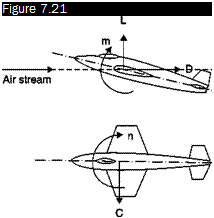. Measuring the aerodynamic forces with balances
7.3.1 Classification of balances
The balance is an important tool in a wind tunnel as it allows the direct measurement of the aerodynamic forces acting on the model. Aerodynamic balances are very complex because, unlike balances used to measure weight, they need to measure a force of which are unknown, and variable during the experiment, the direction, the sign and the point of application. In the most general 3D field, it is therefore necessary to measure three forces acting along three axes to find the direction of the aerodynamic force and three torques acting around the same axes to determine the point of application of the force. In the case of 2D motion, it is enough to measure two forces and one moment.
The balances may be classified as:
■ permanent balances: they are part of the wind tunnel and are placed outside the test chamber (Figures 7.1, 7.6 and 7.8); typically one axis is directed in the direction of the axis of the wind tunnel, and hence of the asymptotic velocity, and another is vertical (so the weight of the model affects only one component of the force and one moment);
■ sting balances, dedicated to each model and incorporated into the sting support (Figures 7.2, 7.3, 7.4 and 7.5); an axis generally coincides with the central axis of the model.
Components of the aerodynamic force
|
r
|
 D drag C side force r rolling moment m pitching moment n yawing moment
D drag C side force r rolling moment m pitching moment n yawing moment
These two systems of axes are respectively the wind axes and the body axes. Usually forces and moments are referred to the wind axis and have the usual names: lift, drag and side force and moments of yaw, roll and pitch (Figure 7.21).
Balances are also classified according to the number of the measured components:
■ one-component balances, able to measure the drag of non-lifting bodies (sphere, cylinder normal to the direction of the velocity and symmetrical airfoils at zero incidence);
■ two-component balances measure lift and drag;
■ three-component balances measure lift, drag and pitching moment;
■ four-component balances measure also the rolling moment;
■ six-component balances give a complete measure of the interaction between body and fluid stream.
Usually, three-component balances are used, sufficient to study symmetrical flight (side force and roll and yaw moments are zero); only rarely are six-component balances required.
In mechanical balances, the force acting on the model is transmitted through a system of levers through a steel yard along which the weights needed for balancing are slid. In electrical balances, the movements produced by forces cause changes in capacitance, inductance or resistance of an electrical circuit; also quartz transducers are used and, mainly, strain gages.
Depending on the method used for the measurement of the force, balances can be classified as: null reading or deformation balances. In both systems it is necessary for the body to move, even if infinitesimally, in the direction of the applied force:
■ the null reading balances measure the force required to bring the model to the position it had before the application of the aerodynamic force;
■ strain gages balances measure the deformation due to the displacement of the model due to the aerodynamic force.
Both methods can be used with any type of support of the model and in any type of wind tunnel. It is just a historical accident that the null reading method has been associated with the permanent balance, which is typical of the low speeds wind tunnels, while the deformation balances were associated with a sting support, mandatory in supersonic wind tunnels.
■ The advantages of permanent balances are the fact that when the measure is made, the model is again in the initial state, the high resolution, the ability to maintain calibration over long periods of time. The disadvantages are the high cost and the time required for the initial alignment and calibration.
■ The advantages of a sting balance are that the initial cost is lower, though this can be offset by the necessity of having to build many balances with different measuring ranges to suit different needs, and that tests are allowed at very high angles of attack. The disadvantage is the fact that the relationship between displacement and applied force must be determined by calibration and can also be nonlinear, and that at the moment of the measurement the model has shifted from its original position.
No balance can be used for all tests on all possible models, but a permanent balance is more versatile, thanks to the width of the measurement range and the adaptability to unforeseen uses.












